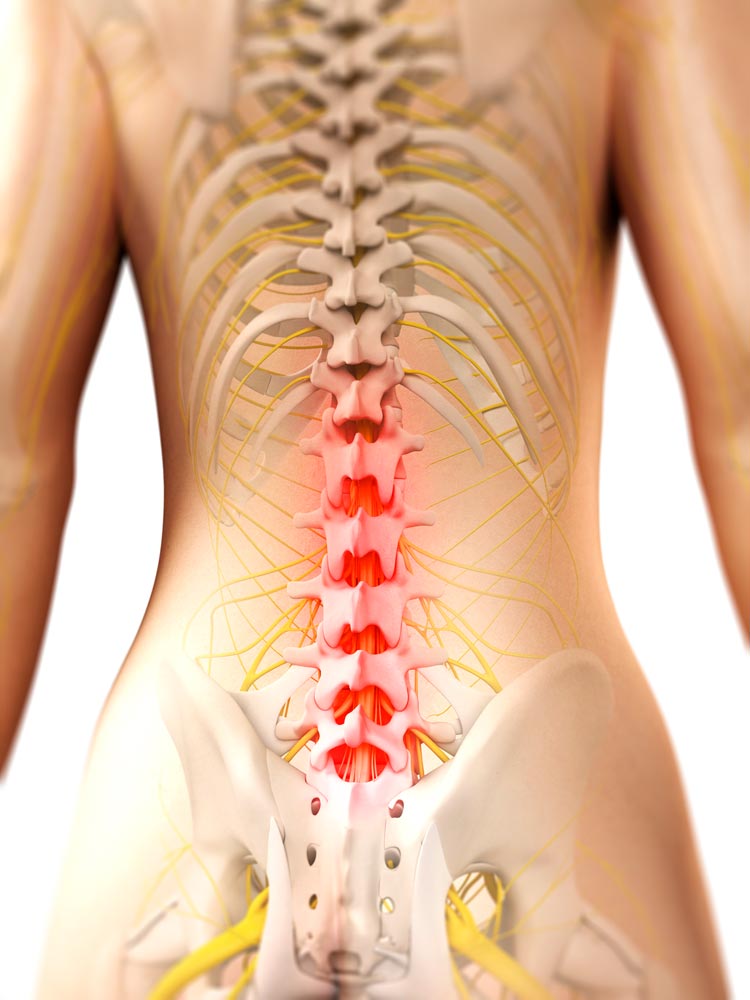 What is a pinched nerve?
What is a pinched nerve?
A pinched nerve occurs when a nerve is squeezed, or compressed, in a tight space in your body. Nerves can be pinched between bones, tendons or muscles. This pressure can cause pain, tingling, numbness or weakness. Pinched nerves often occur in the neck or back, as well as other areas of the body such as arms or wrists. Radiculopathy can be caused by a specific injury, overuse of a certain part of your body or just due to aging. For many people, time and rest are the only treatments needed to fix a pinched nerve.
Types of pinched nerves
The type of pinched nerve depends on the specific location in your body or back. Most pinched nerves start in the neck (cervical radiculopathy), upper-middle back (thoracic radiculopathy) or lower back (lumbar radiculopathy).
- Cervical radiculopathy – Neck pain that can also affect your shoulder and arms
- Thoracic radiculopathy – You may notice pain around your chest area
- Lumbar radiculopathy – Low-back pain that can also be felt in your hips, buttocks and legs
- Other types of pinched nerves – Pinched nerves can also occur in your arm, elbow (ulnar neuropathy), wrist (carpal tunnel syndrome), or hand
What causes a pinched nerve?
A pinched nerve occurs when a nerve is compressed between bones, tendons or muscles. This compression can be caused by wear and tear due to aging, injury from an accident or sports activity or overuse from doing repetitive tasks. Additionally, some conditions can lead to a pinched nerve, such as:
- Herniated disc
- Spinal stenosis
- Spine tumors
- Additionally, having diabetes increases your risk for developing a pinched nerve.
Pinched nerve symptoms
Pain from a pinched nerve typically includes one or more of the following symptoms:
- Numbness
- Sharp, aching or burning pain
- Tingling or the “pins and needles” feeling
- Feeling of weakness with some activities
- Pain radiating outward from the injured area
- Worsened pain with some movements, such as turning your head
- Feeling that your hand or foot has fallen asleep
How long does a pinched nerve last?
The symptoms of most pinched nerves will gradually go away with time (typically four to six weeks). The pain can go away as quickly as a couple of weeks. It’s common for cervical radiculopathy to return sometime in the future.
Diagnosing pinched nerves
Your doctor may tell you to rest, the standard home-care treatment, before you make an appointment.
If it doesn’t improve, your doctor will conduct a physical exam to determine the location of your pinched nerve.
In some cases, imaging tests such as X-rays, computed tomography (CT) scans or magnetic resonance imaging (MRI) scans may be used to make a diagnosis. In addition, our experts doctors at Ohio State may request electromyography and nerve conduction studies (EMG/NCS) to evaluate you for a pinched nerve issue.
Pinched nerve treatment
For most people, the only treatment needed for a pinched nerve is time and rest. Always talk with your doctor about any treatment options, even at-home options.
At-home treatment options
- Apply ice and heat to the pinched nerve area —ice, a cold pack, a warm cloth or a heating pad on a low setting can be placed on the affected area for 10 to 20 minutes at a time. Be sure to put a thin cloth between an ice pack or heating pad and your skin.
- Take over-the-counter anti-inflammatory medications and pain relievers such as acetaminophen and ibuprofen.
- Brace the area with splints or cervical collars to limit motion as your body recovers.
- Avoid being in one position too long; take short breaks to stretch, move around and change positions.
Nonsurgical treatments
- Corticosteroids – Nonsteroidal anti-inflammatory drugs (NSAIDs) or corticosteroids may be prescribed by your doctor.
- Physical therapy – Certain stretches and exercise can help ease pressure on your nerves.
Surgery for a pinched nerve
If there isn’t any improvement after several weeks of trying nonsurgical options, your doctor may recommend a surgical procedure to take pressure off the pinched nerve. The type of surgery will depend on your specific condition. Some examples of surgeries to treat radiculopathy include:
- Disc replacement surgery
- Foraminotomy – a type of surgery that enlarges the area around a bone in the spinal column
- Minimally invasive spinal decompression surgery (discectomy, laminectomy, foraminotomy)
- Spinal decompression surgery (discectomy, laminectomy) with or without spinal fusion
Research
Ohio State conducts innovative research in the laboratory, as well as through clinical trials.
Those who have a pinched nerve may be eligible to participate in one of the following areas of research at The Ohio State University Wexner Medical Center.
Biomechanical testing: We’re doing biomechanical testing to assess the spine before and after surgery. A specialized vest helps us assess your spinal movement and measure the effectiveness of surgery. It ultimately may provide valuable information about which treatment methods will best increase mobility and function of the spine.
Back pain consortium: We’re members of the International Consortium for Health Outcomes Measurement (ICHOM). Membership in this elite organization allows us to engage with other top U.S. medical centers in global research studies on back pain. As we measure our results against established international standards, we share best practices and elevate our standard of care.
Degenerative disc disease surgery: Andrew’s story
Meet Andrew: His degenerative spine disorder caused pinched nerves and severe back pain. Nonsurgical treatments didn’t relieve his pain, so he chose to have minimally invasive surgery at Ohio State. Thanks to Ohio State Spine Care, Andrew is living pain-free.
Patient Education Animation Library
How would you like to schedule?
Don’t have MyChart? Create an account

